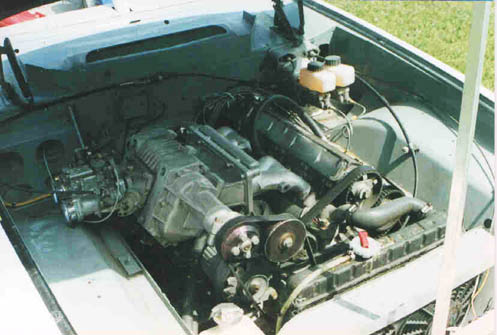


What's Involved
In Supercharging A 907 Engine?
by Duane Kennard
SUPERCHARGING EH?? That should be fun on the 907 engine. As long as boost levels and RPM are kept to a conservative level, the stock engine (fresh, not tired) should hold up OK. I'm guessing that the stock JH version of the 907 can use up to around 6 psi boost with no trouble; more if the internals are upgraded (mainly pistons; possibly cylinder sealing and dowling the block).
First, you'll
need to pick the type of supercharger you want to use.There are a couple.
Most people know of exhaust driven superchargers (turbochargers), but
I'm guessing that you want to know about a belt-driven supercharger.
With the belt-driven variety, you have positive displacement ("Roots"
type being the most common, but there are others), and centrifugal superchargers.
Positive displacement blowers like the Roots type, are generally thought
to be the more responsive, making boost right off idle as soon as you
put your foot in it. Roots blowers are also the type most people picture
when they hear "supercharger", as they're the kind typically
seen on drag-race V8s.
Centrifugal superchargers are something like a turbo that's (usually)
belt driven, instead of exhaust gas driven. While a belt driven centrifugal
supercharger doesn't have to wait to "spool up" like a turbo,
they don't pump a large volume of air right away, like a positive displacement
blower does.
Because of this, I think they're better suited for use at higher RPMS,
and the Roots type (or other positive displacement) is better suited
for street use. Of course, each type has advantages and disadvantages.
There's lots of information about supercharger types both in books,
and on the internet; anyone thinking about doing it needs to read up.
Once you decide on which type of supercharger you want, you need to
pick one that's the proper size for your engine's displacement. Depending
upon the intended RPM range, and driving style, that size can be a little
larger or smaller than the ideal, and the supercharger then under, or
overdriven to compensate. Once the style and size are decided on, you
need to think about mounting, plumbing, and driving the supercharger.
Since I don't know of anyone already making supercharger kits for the
907, there will be some fabrication involved (OK; lots..). Parts that
need to be made are intake manifolds or adapters to existing manifolds,
and mounting brackets. You'll also need to adapt a pulley to the crankshaft
to drive the supercharger. If you use a centrifugal and want to go with
an intercooler, there's even more to fabricate... Once the supercharger
is mounted and the drive system figured out, you need to think about
feeding the engine with the proper amount of fuel for all the extra
air it will now be pumping.
Chances are that you'll need to upgrade your fuel pump to give more
volume. I'm guessing that most JH owners will want to stick with carburetors,
and if so, Webers or Dellortos would probably be best suited, though
the smallest of the American 4 barrel carbs could be adapted as well
(old 400 cfm Carter may work well, and Holley still makes a 390 cfm
intended for four cyl. engines). If they're brave souls, and want to
stick with British carbs, then adapting S.U.'s is also an option, but
needle selection probably isn't as good as it was years ago.
Once carburation is figured out, ignition needs to be looked at. Running
under boost will tax any ignition system, but there's lots of modern
stuff available that will help you run reliably. Chances are, you'll
need to run some kind of ignition controller that will retard the ignition
system when in boost, so that your engine will avoid detonation. Oh;
and you'll also need to run higher octane fuel. Pump super at 91 or
more octane should be considered a bare minimum. You'll most probably
have the best results with an octane rating of 94 or more. Racing gas
works well, but is expensive. Commercial octane boosters work, but not
as well as adding aromatics to the pump super (toluene or xylene). While
I know that I've probably left out something important, the things I
mentioned here are all things that need to be considered.
If you're still
interested, a must read book is “A Do-it Yourself Guide To
STREET SUPERCHARGING” , ISBN 0-931472-17-2.
Bottom line, it will be a lot of work, fabrication and expense to supercharge
the 907, but if done properly, the results could be worth the trouble!
Consider that well designed, turn-key supercharger kits for many modern cars (like BMWs) run in the $4,000 - $6,000 range which will give you some idea of the amount of work that goes into it. – Editor
This supercharged Jensen Healey belongs to club member Andy Frazen of Houston, Texas.

main | jensen | tech | people & places | marketplace | message board | join | garage | links | mail